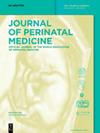Clinical characteristics and outcomes of women with adenomyosis pain during pregnancy: a retrospective study
IF 1.4
4区 医学
Q3 OBSTETRICS & GYNECOLOGY
引用次数: 0
Abstract
Objectives Adenomyosis is associated with unfavorable perinatal outcomes, and recent case reports show that some women with adenomyosis experience pain at the adenomyosis lesion during pregnancy and have detrimental perinatal outcomes. This study aimed to clarify the clinical characteristics of this pain and perinatal outcomes associated with this phenomenon. Methods This was a single-center retrospective analysis of pregnant women with adenomyosis. The incidence of pain onset at adenomyosis lesions, defined as persistent pain at the adenomyosis site with administration of analgesics for pain relief, and its association with perinatal outcomes were analyzed. Results Among 91 singleton pregnancies with adenomyosis, 12 pregnancies (13.2 %) presented with pain. One pregnancy resulted in second-trimester miscarriage, and 5 of the 11 pregnancies (45 %) developed preeclampsia, which resulted in preterm delivery, and 3 of the 12 pregnancies (25 %) achieved term delivery. The incidence of preeclampsia and preterm delivery was higher in those who experienced pain than in those without (45 % [5/11] vs. 15 % [11/74]; p<0.05, and 73 % [8/11] vs. 34 % [25/74]; p<0.05, respectively). Among women with pain, the maximum C-reactive protein level was significantly higher in women who developed preeclampsia than in those who did not (5.45 vs. 0.12 mg/dL, p<0.05). Conclusions Our study revealed that adenomyosis can cause pain in over one of eight pregnancies with adenomyosis, which may be associated with the increased incidence of preeclampsia resulting in preterm delivery. Women with pain, especially those with high C-reactive protein levels, may be at high risk for future development of preeclampsia and consequent preterm delivery.妊娠期子宫腺肌症疼痛妇女的临床特征和预后:一项回顾性研究
目的:子宫腺肌症与不利的围产期结局有关,最近的病例报告显示,一些患有子宫腺肌症的妇女在怀孕期间会感到腺肌症病灶处疼痛,并对围产期结局造成不利影响。本研究旨在阐明这种疼痛的临床特征以及与这种现象相关的围产期结局。方法 这是一项针对子宫腺肌症孕妇的单中心回顾性分析。研究分析了子宫腺肌症病变部位疼痛的发生率(定义为使用镇痛药止痛后子宫腺肌症部位出现持续性疼痛)及其与围产期结局的相关性。结果 在91例患有子宫腺肌症的单胎妊娠中,有12例(13.2%)出现疼痛。一名孕妇在第二胎流产,11 名孕妇中有 5 名(45%)出现子痫前期,导致早产,12 名孕妇中有 3 名(25%)足月分娩。有阵痛的孕妇子痫前期和早产的发生率高于无阵痛的孕妇(分别为 45% [5/11] 对 15% [11/74];p<0.05;73% [8/11] 对 34% [25/74];p<0.05)。在有疼痛的妇女中,发生子痫前期的妇女的 C 反应蛋白最高水平明显高于未发生子痫前期的妇女(5.45 vs. 0.12 mg/dL,p<0.05)。结论 我们的研究表明,子宫腺肌症可导致八分之一以上的子宫腺肌症孕妇出现疼痛,这可能与子痫前期导致早产的发生率增加有关。患有子宫腺肌症的妇女,尤其是 C 反应蛋白水平较高的妇女,可能是将来发展为子痫前期并导致早产的高危人群。
本文章由计算机程序翻译,如有差异,请以英文原文为准。
求助全文
约1分钟内获得全文
求助全文
来源期刊

Journal of Perinatal Medicine
医学-妇产科学
CiteScore
4.40
自引率
8.30%
发文量
183
审稿时长
4-8 weeks
期刊介绍:
The Journal of Perinatal Medicine (JPM) is a truly international forum covering the entire field of perinatal medicine. It is an essential news source for all those obstetricians, neonatologists, perinatologists and allied health professionals who wish to keep abreast of progress in perinatal and related research. Ahead-of-print publishing ensures fastest possible knowledge transfer. The Journal provides statements on themes of topical interest as well as information and different views on controversial topics. It also informs about the academic, organisational and political aims and objectives of the World Association of Perinatal Medicine.
 求助内容:
求助内容: 应助结果提醒方式:
应助结果提醒方式:


